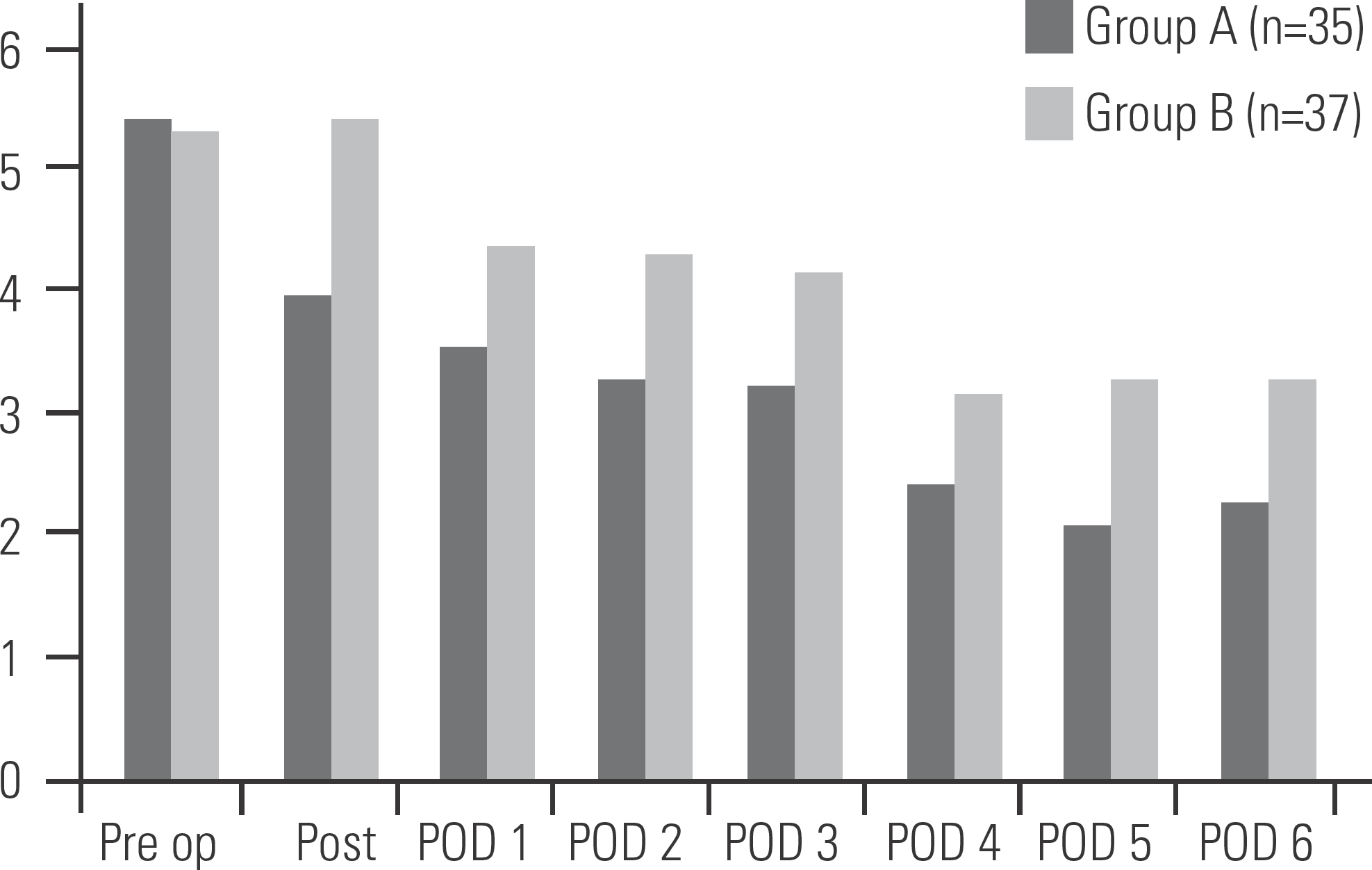Abstract
Objectives
This study was conducted to evaluate the effects of using an epidural steroid sponge for postoperative pain control in lumbar discectomy.
Summary of Literature Review
There are many methods to control postoperative pain after lumbar discectomy, including opioid analgesics, epidural catheters, and epidural steroid Gelfoam sponges.
Materials and Methods
A total of 72 patients who underwent surgery between March 2011 and February 2014 were enrolled. Their average age was 54 years (range, 24–82 years). In group A (35 patients), Gelfoam was inserted after being soaked with a solution of 2% lidocaine (400 mg/20 mL; 1 vial) and dexamethasone (5 mg/mL; 1 ampoule). In group B (37 patients), it was inserted after soaking with normal saline. Postoperative pain was assessed by visual analogue scale (VAS) scores. Pain above 5 points was controlled by a narcotic analgesic agent, and the duration and number of postoperative interventions, the period of time before walking after the operation, and the period until the date of discharge after surgery were assessed and compared. The Mann-Whitney U test was used as a nonparametric method. P-values less than 0.05 were considered to indicate statistical significance.
Results
In group A, 15 patients did not require analgesics on the day of surgery. In 20 patients, no analgesics were needed on postoperative day (POD) 1. In group B, 8 patients on the day of surgery and 13 patients on POD 1 did not require analgesics. In group A, 26 patients were able to walk on the day of surgery, and all patients were able to walk on POD 1. In group B, 19 patients was able to walk on the day of surgery and all patients were able to walk on POD 1. The mean number of hospital days before discharge was 6.3 in group A and 8.2 in group B.
Go to : 
REFERENCES
1. Bianconi M, Ferraro L, Ricci R, et al. The pharma-cokinetics and efficacy of ropivacaine continuous wound instillation after spine fusion surgery. Anesth Analg. 2004 Jan; 98(1):166–72. DOI: 10.1213/01. ANE.0000093310.47375.44.

2. Raw DA, Beattie JK, Hunter JM. Anaesthesia for spinal surgery in adults. Br J Anaesth. 2003 Dec; 91(6):886–904. DOI: 10.1093/bja/aeg253.

3. Grabow L, Kremer G, Stannigel H, et al. Intraoperative epidural opiate analgesia for pain treatment after spine surgery (author's transl.). Anasth Intensivther Notfallmed. 1982 Apr; 17(2):96–7. DOI: 10.1055/s-2007-1003855.
4. Ibrahim AW, Farag H, Naguib M. Epidural morphine for pain relief after lumbar laminectomy. Spine(Phila Pa 1976). 1986 Dec; 11(10):1024–6. DOI: 10.1097/00007632-198612000-00010.

5. Schimidek HH, Cutler SG. Epidural morphine for control of pain after spinal surgery: a preliminary report. Neurosurgery. 1983 Jul; 13(1):37–9. DOI: 10.1227/00006123-198307000-00006.
6. Kondo U, Yokota S, Nonogaki M, et al. Continuous epidural morphine for postoperative pain relief after spinal surgery: use of an epidural catheter placed at the time of surgery. Masui. 1997 Aug; 46(8):1078–84.
7. Teddy PJ, Adams CB, Briggs M, et al. Extradural diamor-phine in the control of pain following lumbar laminectomy. J Neurol Neurosurg Psychiatry. 1981 Dec; 44(12):1074–8. DOI: 10.1136/jnnp.44.12.1074.

8. Kluba T, Hofmann F, Bredanger S, et al. Efficacy of postoperative analgesia after posterior lumbar instrumented fusion for degenerative disc disease: A prospective ran-domized comparison of epidural catheter and intravenous administration of analgesics. Orthop Rev (Pavia). 2010 Mar 20; 2(1):e927–30. DOI: 10.4081/or.2010.e9.

9. Mugabure Bujedo B. A clinical approach to neuraxial morphine for the treatment of postoperative pain. Pain Res Treat. 2012; 2012:612145. DOI: 10.1155/2012/612145.

10. Gibbons KJ, Barth AP, Ahuja A, et al. Lumbar discectomy: Use of an epidural morphine sponge for postoperative pain control. Neurosurgery. 1995 Jun; 36(6):1131–6. DOI: 10.1227/00006123-199506000-00010.
11. Mishra LD, Nath SS, Gairola RL, et al. Buprenorpine-soaked absorbable gelatin sponge: An alternative method for postlaminectomy pain relief. J Neurosurg Anesthe-siol. 2004 Apr; 16(2):115–21. DOI: 10.1097/00008506-200404000-00002.
12. Chadduck JB, Sneyd JR, Pobereskin LH. The role of bupivacaine in early postoperative pain control after lumbar decompression. J Neurosurg. 1999 Jan; 90(1 Suppl):67–72. DOI: 10.3171/spi.1999.90.1.0067.

13. Davis R, Emmons SE. Benefits of epidural methylpred-nisolone in a unilateral lumbar discectomy: a matched controlled study. J Spinal Disord. 1990 Dec; 3(4):299–306. DOI: 10.1097/00002517-199012000-00004.
14. McEvoy GK. AHFS drug information. Wisconsin: Ameri-can Society of Health-system Pharmacists. 1996. 2361–2.

15. Bromage PR. Mechanism of action of extradural analgesia. Br J Anaesth. 1975 Feb; 47(suppl):199–211.
16. SON H.K., Moon C.T., Cho J. The Use of Corticoste-roids and Bupivacaine for Pain Management in Lumbar Disc Herniation Patient. J Korean Neurosurg Soc. 1996 Sep; 25(9):1794–98.
17. Lowell TD, Errico TJ, Eskenazi MS. Use of epidural steroids after discectomy may predispose to infection. Spine (Phila Pa 1976). 2000 Feb; 25(4):516–9. DOI: 10.1097/00007632-200002150-00020.

18. Kumari K, Kamal M, Singariya G, Kishan R, Garg S, Thanvi S. Effect of epidural levobupivacaine with or without dexamethasone soaked in gelfoam for postoperative analgesia after lumbar laminectomy: A double blind, randomised, controlled trial. Indian J Anaesth. 2018; 62:509–15. DOI: 10.4103/ija.IJA_128_18. DOI: 10.4103/ija.ija_128_18.

Go to : 
Table 1.
Patient demographics
| Steroid group (A) | Control group (B) | Significance | |
|---|---|---|---|
| Mean age (yr) | 53 | 54.9 | Not significant |
| Operative time (min) | 86 | 86.3 | Not significant |
| Level (L4/5, L5/S1, Etc.) | 20/9/6 | 22/8/7 | Not significant |




 PDF
PDF Citation
Citation Print
Print



 XML Download
XML Download